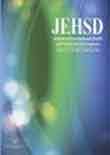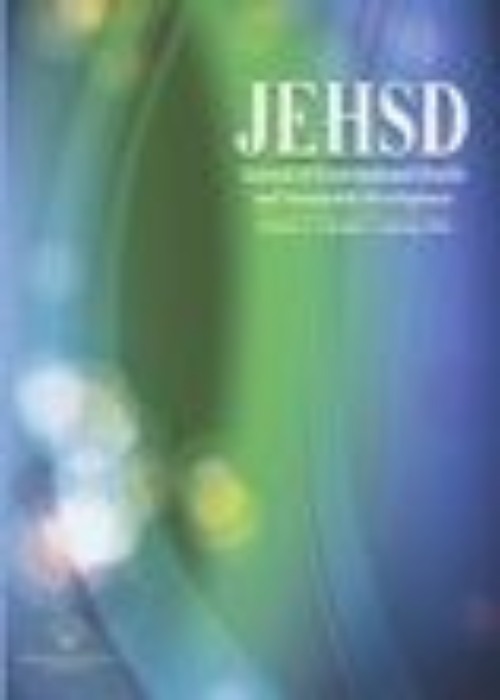فهرست مطالب

Journal of Environmental Health and Sustainable Development
Volume:2 Issue: 4, Dec 2017
- تاریخ انتشار: 1396/09/01
- تعداد عناوین: 8
-
Pages 379-387IntroductionThe present study aimed to compare the performance of two widely-used models for spatial assessment of particulate matter less than 10 microns (PM10) in ambient air of Yazd city. Finally, effective factors on concentrations of pollutants and corresponding standards were investigated.Materials And MethodsA number of 13 sampling stations were employed in different areas of Yazd to sample PM10 within two seasons of winter and spring of 2012 and 2013. PM10 was measured by HAZ-DUST EPAM-5000 particulate air monitor. In order to assess the efficiency of Kriging and Inverse Distance Weighting (IDW) models for PM10 zoning, the statistical Root Mean Square Error (RMSE) and %RMSE methods were used in the Arc GIS software version 10.1.ResultsThe highest (297 µg/m3) and lowest concentrations (35.8 µg/m3) of PM10 in spring were found in high-traffic historical regions and low-traffic suburban areas, respectively. High-traffic and historical regions had higher levels of PM10 compared to other regions. Given the values of RMSE and %RMSE indicators, Kriging interpolation method was better for zoning of the pollutant PM10 in both winter and spring.ConclusionAccording to higher concentration of PM10 compared to WHO standard values particularly in spring, necessary actions and solutions should be taken for the pollution reduction. This study indicated that Kriging model has a better efficiency for spatial analysis of suspended particles, compared to IDW method.Keywords: Suspended Particles, Interpolation, Kriging Model, Geographic Information, System, Yazd City.
-
Pages 388-398IntroductionCutaneous leishmaniasis can lead to the loss of time, labor force, significant treatment costs and psychological problems. Also, cutaneous leishmaniasis is considered as an important health problem in Iran. This study was aimed at investigating the status of cutaneous leishmaniasis in Dashtestan district.Materials And MethodsThis cross-sectional and descriptive-correlational survey was performed on all confirmed leishmaniasis cases (86 person) following up in Dashtestan district health care centers during 2013-2014. Patients general information such as age, sex, geographical region, number and site of ulcer, as well as the month and season of incidence were registered and analyzed by SPSS ver.24. All ethical issues were also addressed.ResultsDuring 2013, the maximum percent frequency of the incidence of cutaneous leishmaniasis was related to the age-group of 0-4 years (41.9%) and during 2014, was related to the age group of 15-24 years (30.2%). During 2013 and 2014, the incidence of cutaneous leishmaniasis was higher in males than in females and the face was the most common site of the ulcer. During 2013 and 2014, autumn and winter had the most seasonal incidence and most of the cases were observed during September and January, respectively.ConclusionBased on the study results, cutaneous leishmaniasis is high endemically in Dashtestan district. Therefore, control measures such as education, optimizing the environment and the application of appropriate coating for exposed age groups, especially children and young people are essential.Keywords: Epidemiology, Leishmaniasis, Parasite, Incidence, Bushehr.
-
Pages 399-406IntroductionCurrently, the conversion of waste from industrial processes to compost through vermicompost has been considered both in terms of health, environmental pollution, and economy. The aim of this study was to investigate the effect of waste process of Halva Ardeh production on vermicompost quality.Materials And MethodsTo determine the best combination of cow manure with Halva Ardeh processing waste according to national standard vermicompost methods; different percentages of cow manure and Halva Ardeh waste, were prepared for vermicompost during 90 days. SPSS software and ANOVA test were used to analyze the data.ResultsThe results showed that during the process of vermicompost, pH initially increased in all treatments and then decreased significantly from the third week afterwards (p ≤ 0.001). Also, the average organic carbon percentage (OC) decreased in all treatments significantly (p = 0.02) and the highest amount of OC was obtained in the control treatment and the lowest amount was related to 1C: 1S treatment. The trend of electrical conductivity changes in all substrates with different treatments was generally decreasing and this decrease was statistically significant (p = 0.035). Furthermore, the amount of carbon to nitrogen (C/N) in all treatments decreased and the average C/N in the control treatment was 56.8% and in the 1C: 1S treatment was 16.9% and this difference was statistically significant (P = 0.023).ConclusionBased on our findings, the compost quality of this study confirms to the standards of compost class A. This method can be used to convert the waste from Halva Ardeh production on vermicompost qulity.Keywords: Halva Ardeh, Quality, Vermicompost, Waste.
-
Pages 407-415IntroductionThe relationship between elevated level of gas and particulate pollutants with increased mortality resulting from cardiovascular and respiratory diseases has been presented in epidemiological studies. Although the principal mechanisms of diseases are still unknown, inflammatory and homeostatic processes have been known to be related to this issue. Accordingly, this study was conducted with the aim of evaluating the relationship between exposure to respirable particulates and blood parameters of workers in a tile and ceramic industry in YazdMaterials And MethodsIn this cross-sectional study, 80 healthy workers who were exposed to mineral particulates participated. To determine the concentration of respirable particulates, sampling was performed on the respiratory area based on NIOSH_0600 method, and the blood parameters were measured using standard method.ResultsThe mean concentration of respirable dust was 2.55 mg/m3, which is lower than standard limit (3 mg/m3). To determine the relationship between the concentration of respirable dust and blood parameters, robust regression test was used and this concentration was significantly and positively correlated with WBC. There was also a significant and negative relationship between MCH and respirable dust in the crude model.ConclusionExposure of individuals to respirable dust within a level of
0.05-82.84 mg/m3 has been followed by elevated WBC. As a significant number of people work in tile and ceramic industry and are exposed to high levels of pollutants and are also susceptible to different diseases, change to improve the work and preventive measures are essential.Keywords: Air Pollution, Blood Parameters, Respirable Particles, Industry. -
Pages 416-421IntroductionMicrobial contamination prediction through detecting the indicator bacteria in natural waters is the first health and environmental step for preventing the transmission of water-associated diseases. This study was designed to determine the correlation between Escherichia coli as the indicator bacterium, on the one hand, and Salmonella and Shigella Spp. As the pathogenic bacteria, on the other hand.Materials And MethodsTotally, 60 natural water samples were collected from natural rivers in Gorgan during summer and autumn of 2016. In order to detect Escherichia coli, the membrane filter method with Endo agar and IMVIC test was used and, in order to detect Salmonella and Shigella, the 9-tube fermentation method and biochemical tests with selenite F medium, XLD agar, TSI, urea, and SIM were utilized. For the statistical analysis, Pearsons correlation test was used at the significance coefficient ofResultsResults showed that all of the analyzed bacteria were detected in the water samples. The frequency of Salmonella, Shigella, Escherichia coli, Klebsiella-Enterobacter, and Citrobacter was 9.5, 22.2, 4.8, 22.2, and 65.1%, respectively. The statistical analysis demonstrated no statistical correlation between Escherichia coli, on the one hand, and Salmonella and Shigella, on the other hand; but the relationship between Salmonella and Shigella was significant.ConclusionJudging the microbial quality of water supplies cannot be sufficient only based on the presence or absence of Escherichia coli bacterium. Therefore, it seems that the use of other secondary indicator bacteria such as fecal streptococci and supplementary sulphite-reducing clostridia will be advised.Keywords: Escherichia Coli, Salmonella, Shigella, Water Pollution, Rivers.
-
Pages 422-431IntroductionOptimization of waste collection systems can reduce waste management costs. In this study, optimization of the waste collection system of zone 3 of Yazd municipality of Iran, has been investigated using underground containers.Materials And MethodsIn this research, after collecting information and performing field inspections, the statistical and raster information obtained from the Yazd municipality and Yazd waste management organization were introduced into ArcGIS software and based on the information obtained, including population density layer and population last estimation in zone 3, per capita waste production, and then considering all the information layers obtained using the GIS software, containers were located with a source separation approach.ResultsThe results of this study indicate that installation of underground containers for wet waste, in addition to improving the health and environmental status, can decrease the frequency of urban waste collection from 3 days to 2 days a week. Moreover, creation of temporary storage sites for dry wastes, can also significantly decrease the route of collection, due to the reduction of the collection route from 368,000 to 180,000 meters in the new routing system, reduce the economic cost, including reducing fuel costs as 50% per day, manpower as 33%, and reduce maintenance costs.ConclusionOptimization of urban waste collection system using underground containers for wet waste and the use of temporary stations of dry wastes, considering the significant economic, environmental and aesthetic advantages can be considered as an appropriate option in Iranian cities especially in areas with hot and humid weather such as Yazd.Keywords: Waste Management, Collection System, GIS, Underground Containers, Yazd City.


